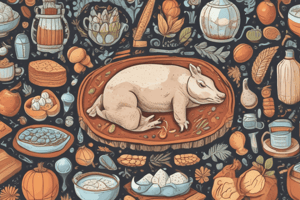Podcast
Questions and Answers
What is the composition of a simple triglyceride?
What is the composition of a simple triglyceride?
- One fatty acid attached to a carbohydrate.
- Three different fatty acids bound to glycerol.
- Two identical fatty acids and one different fatty acid.
- Three identical fatty acids bound to glycerol. (correct)
Which of the following amino acids is classified as non-essential?
Which of the following amino acids is classified as non-essential?
- Arginine
- Valine
- Alanine (correct)
- Histidine
What is the function of protein breakdown in the body?
What is the function of protein breakdown in the body?
- It converts proteins directly into glucose.
- It reduces excess ammonia by converting it to urea. (correct)
- It aids in synthesizing fatty acids.
- It enhances the absorption of carbohydrates.
How does fat aid energy metabolism in the diet?
How does fat aid energy metabolism in the diet?
What effect does lignin have on the digestibility of dietary components?
What effect does lignin have on the digestibility of dietary components?
What does DE represent in the context of feed energy?
What does DE represent in the context of feed energy?
Which statement accurately describes the composition of mixed triglycerides?
Which statement accurately describes the composition of mixed triglycerides?
What indicates the presence of essential amino acids in protein sources?
What indicates the presence of essential amino acids in protein sources?
Which of the following factors contributes to the difficulty in fat digestion in the stomach?
Which of the following factors contributes to the difficulty in fat digestion in the stomach?
What role does ammonia play in the metabolism of dietary protein?
What role does ammonia play in the metabolism of dietary protein?
Which of the following carbohydrates is predominantly found in whole grain cereals?
Which of the following carbohydrates is predominantly found in whole grain cereals?
What is the primary reason for the role of bile in fat digestion?
What is the primary reason for the role of bile in fat digestion?
What is one of the primary functions of dietary fat?
What is one of the primary functions of dietary fat?
Flashcards are hidden until you start studying
Study Notes
Animal Nutrition
- Feeds and forages are essential components for animal diets and include various nutrients necessary for growth and development.
Carbohydrates (CHO)
- Carbohydrates are primary energy sources for animals, classified as simple or complex sugars.
- Lignin is indigestible, negatively affecting the digestibility of fiber and protein.
- Whole grain cereals, such as barley, are rich in starch, primarily in the forms of amylose and amylopectin, which are located in the endosperm.
Energy, Protein, and Fibre Sources
- Energy sources include grains and fats, which provide high-caloric diets necessary for growth and maintenance.
- Protein sources in livestock diets include grass and cottonseed meal, providing essential amino acids.
- Fibre supports digestive health and gut function in animals.
Fat and Energy in the Diet
- Fats, primarily triglycerides, are composed of glycerol and three fatty acids, serving as a concentrated energy source.
- Simple triglycerides contain identical fatty acids, whereas mixed triglycerides consist of different fatty acids.
- Dietary fat aids in the absorption of fat-soluble vitamins and provides essential fatty acids.
Digestion of Fat
- Fat globules are challenging to digest in the stomach, requiring movement to the small intestines for further breakdown.
- Pancreatic lipase, activated by bile, facilitates the emulsification and breakdown of fats into fatty acids.
Protein Structure and Function
- Proteins are made from amino acids, which can be categorized into essential and non-essential groups.
- Essential amino acids include arginine and histidine; non-essential amino acids include alanine and glycine.
- Amino acids are broken down into ammonia, which is converted to urea for excretion when in excess.
Metabolism and Measurement of Energy in Ruminants
- Digestible Energy (DE) refers to the fraction of feed energy that is absorbed and utilized by the body, excluding energy lost in feces.
- Understanding the partitioning of feed energy helps optimize ruminant diets for efficient nutrient utilization.
Animal Nutrition
- Feeds and forages are essential components for animal diets and include various nutrients necessary for growth and development.
Carbohydrates (CHO)
- Carbohydrates are primary energy sources for animals, classified as simple or complex sugars.
- Lignin is indigestible, negatively affecting the digestibility of fiber and protein.
- Whole grain cereals, such as barley, are rich in starch, primarily in the forms of amylose and amylopectin, which are located in the endosperm.
Energy, Protein, and Fibre Sources
- Energy sources include grains and fats, which provide high-caloric diets necessary for growth and maintenance.
- Protein sources in livestock diets include grass and cottonseed meal, providing essential amino acids.
- Fibre supports digestive health and gut function in animals.
Fat and Energy in the Diet
- Fats, primarily triglycerides, are composed of glycerol and three fatty acids, serving as a concentrated energy source.
- Simple triglycerides contain identical fatty acids, whereas mixed triglycerides consist of different fatty acids.
- Dietary fat aids in the absorption of fat-soluble vitamins and provides essential fatty acids.
Digestion of Fat
- Fat globules are challenging to digest in the stomach, requiring movement to the small intestines for further breakdown.
- Pancreatic lipase, activated by bile, facilitates the emulsification and breakdown of fats into fatty acids.
Protein Structure and Function
- Proteins are made from amino acids, which can be categorized into essential and non-essential groups.
- Essential amino acids include arginine and histidine; non-essential amino acids include alanine and glycine.
- Amino acids are broken down into ammonia, which is converted to urea for excretion when in excess.
Metabolism and Measurement of Energy in Ruminants
- Digestible Energy (DE) refers to the fraction of feed energy that is absorbed and utilized by the body, excluding energy lost in feces.
- Understanding the partitioning of feed energy helps optimize ruminant diets for efficient nutrient utilization.
Studying That Suits You
Use AI to generate personalized quizzes and flashcards to suit your learning preferences.




